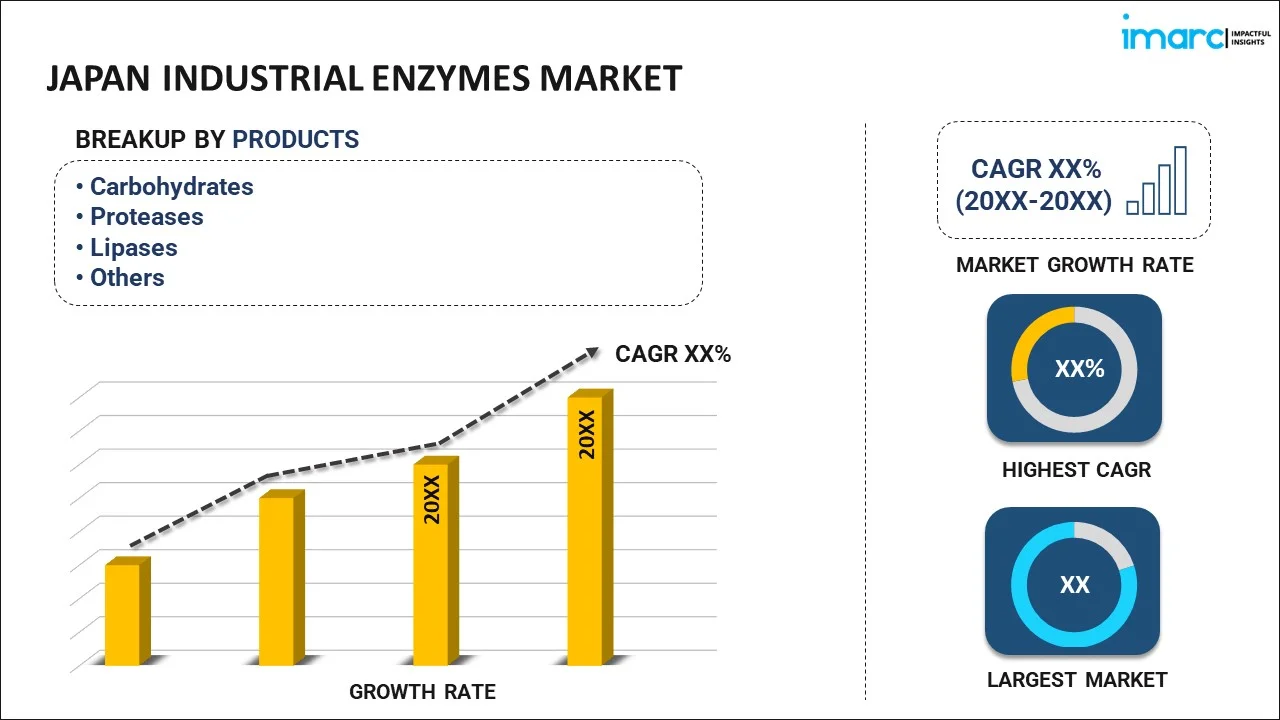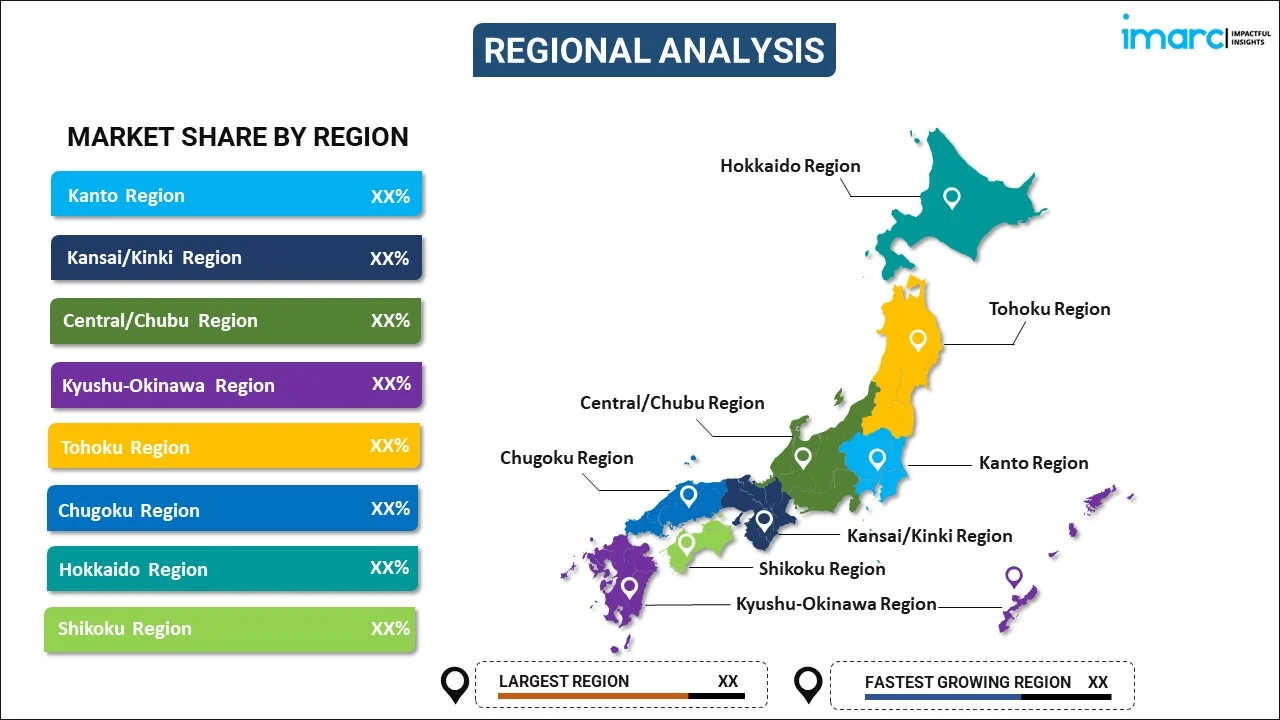
Japan Industrial Enzymes Market Report by Product (Carbohydrates, Proteases, Lipases, Polymerases and Nucleases, and Others), Source (Plants, Animals, Microorganisms), Application (Food and Beverages, Detergents, Animal Feed, Biofuels, Textiles, Pulp and Paper, Nutraceuticals, Personal Care and Cosmetics, Wastewater Treatment, and Others), and Region 2025-2033
Market Overview:
Japan industrial enzymes market size reached USD 382.5 Million in 2024. Looking forward, IMARC Group expects the market to reach USD 797.1 Million by 2033, exhibiting a growth rate (CAGR) of 7.7% during 2025-2033. The market is being driven by several factors, including growing investments in the infrastructure and technology for enzyme production, a rising inclination toward sustainable and environmentally friendly manufacturing methods, and the introduction of novel applications for enzymes across multiple industries.
|
Report Attribute
|
Key Statistics
|
|---|---|
|
Base Year
|
2024 |
|
Forecast Years
|
2025-2033
|
|
Historical Years
|
2019-2024
|
| Market Size in 2024 | USD 382.5 Million |
| Market Forecast in 2033 | USD 797.1 Million |
| Market Growth Rate (2025-2033) | 7.7% |
Industrial enzymes hold a pivotal position as catalysts in a wide array of industrial operations and food manufacturing processes, such as the production of bread and cheese. These enzymes are derived from plant tissues, animal tissues, or microorganisms and serve to expedite and enhance chemical reactions by forming transition state complexes with the substances they act upon. Moreover, they assume a vital role in various metabolic functions within the human body, including assisting in food digestion and the synthesis of DNA. Thanks to their adaptability and efficacy, industrial enzymes find practical applications across various industry sectors, spanning from animal feed and biofuels to cleaning agents. Their extensive usage across diverse domains underscores their importance in contemporary manufacturing and production procedures, contributing to heightened efficiency and sustainability.
Japan Industrial Enzymes Market Trends:
The Japan industrial enzymes market is primarily steered by significant growth within the food and beverage sector. Industrial catalysts are experiencing increased utilization in this sector for the manufacturing of packaged and processed food items. The use of these catalysts aids in the breakdown of nutrients during metabolic reactions and the conversion of complex molecules into simpler ones, thereby propelling market expansion. Additionally, there is a noteworthy surge in the adoption of biofuels, driven by an escalating emphasis on sustainable development, which is acting as another significant growth-inducing factor. Besides this, various industrial enzymes, including lipase and phospholipase, play an indispensable role in biofuel production, further augmenting the demand for these catalysts. Moreover, the market also benefits from the escalating sales of nutraceuticals and functional foods on a wide scale, with industrial enzymes featuring prominently in their manufacturing processes. Apart from this, fueled by the increasing health consciousness among individuals and their rising disposable incomes, this trend augments the market's favorable outlook. Other contributing factors encompass rapid industrialization, ongoing advancements in food technology, and consistent research and development (R&D) initiatives in the field of protein engineering. They are expected to fuel the regional market in the coming years.
Japan Industrial Enzymes Market Segmentation:
IMARC Group provides an analysis of the key trends in each segment of the market, along with forecasts at the country level for 2025-2033. Our report has categorized the market based on product, source, and application.
Product Insights:

- Carbohydrates
- Amylases
- Cellulase
- Others
- Proteases
- Lipases
- Polymerases and Nucleases
- Others
The report has provided a detailed breakup and analysis of the market based on the product. This includes carbohydrates (amylases, cellulase, and others), proteases, lipases, polymerases and nucleases, and others.
Source Insights:
- Plants
- Animals
- Microorganisms
A detailed breakup and analysis of the market based on the source have also been provided in the report. This includes plants, animals, and microorganisms.
Application Insights:
- Food and Beverages
- Detergents
- Animal Feed
- Biofuels
- Textiles
- Pulp and Paper
- Nutraceuticals
- Personal Care and Cosmetics
- Wastewater Treatment
- Others
The report has provided a detailed breakup and analysis of the market based on the application. This includes food and beverages, detergents, animal feed, biofuels, textiles, pulp and paper, nutraceuticals, personal care and cosmetics, wastewater treatment, and others.
Regional Insights:

- Kanto Region
- Kansai/Kinki Region
- Central/ Chubu Region
- Kyushu-Okinawa Region
- Tohoku Region
- Chugoku Region
- Hokkaido Region
- Shikoku Region
The report has also provided a comprehensive analysis of all the major regional markets, which include Kanto Region, Kansai/Kinki Region, Central/ Chubu Region, Kyushu-Okinawa Region, Tohoku Region, Chugoku Region, Hokkaido Region, and Shikoku Region.
Competitive Landscape:
The market research report has also provided a comprehensive analysis of the competitive landscape. Competitive analysis such as market structure, key player positioning, top winning strategies, competitive dashboard, and company evaluation quadrant has been covered in the report. Also, detailed profiles of all major companies have been provided.
Japan Industrial Enzymes Market Report Coverage:
| Report Features | Details |
|---|---|
| Base Year of the Analysis | 2024 |
| Historical Period | 2019-2024 |
| Forecast Period | 2025-2033 |
| Units | Million USD |
| Scope of the Report | Exploration of Historical and Forecast Trends, Industry Catalysts and Challenges, Segment-Wise Historical and Predictive Market Assessment:
|
| Products Covered |
|
| Sources Covered | Plants, Animals, Microorganisms |
| Applications Covered | Food and Beverages, Detergents, Animal Feed, Biofuels, Textiles, Pulp and Paper, Nutraceuticals, Personal Care and Cosmetics, Wastewater Treatment, Others |
| Regions Covered | Kanto Region, Kansai/Kinki Region, Central/ Chubu Region, Kyushu-Okinawa Region, Tohoku Region, Chugoku Region, Hokkaido Region, Shikoku Region |
| Customization Scope | 10% Free Customization |
| Post-Sale Analyst Support | 10-12 Weeks |
| Delivery Format | PDF and Excel through Email (We can also provide the editable version of the report in PPT/Word format on special request) |
Key Questions Answered in This Report:
- How has the Japan industrial enzymes market performed so far and how will it perform in the coming years?
- What has been the impact of COVID-19 on the Japan industrial enzymes market?
- What is the breakup of the Japan industrial enzymes market on the basis of product?
- What is the breakup of the Japan industrial enzymes market on the basis of source?
- What is the breakup of the Japan industrial enzymes market on the basis of application?
- What are the various stages in the value chain of the Japan industrial enzymes market?
- What are the key driving factors and challenges in the Japan industrial enzymes?
- What is the structure of the Japan industrial enzymes market and who are the key players?
- What is the degree of competition in the Japan industrial enzymes market?
Key Benefits for Stakeholders:
- IMARC’s industry report offers a comprehensive quantitative analysis of various market segments, historical and current market trends, market forecasts, and dynamics of the Japan industrial enzymes market from 2019-2033.
- The research report provides the latest information on the market drivers, challenges, and opportunities in the Japan industrial enzymes market.
- Porter's five forces analysis assist stakeholders in assessing the impact of new entrants, competitive rivalry, supplier power, buyer power, and the threat of substitution. It helps stakeholders to analyze the level of competition within the Japan industrial enzymes industry and its attractiveness.
- Competitive landscape allows stakeholders to understand their competitive environment and provides an insight into the current positions of key players in the market.
Need more help?
- Speak to our experienced analysts for insights on the current market scenarios.
- Include additional segments and countries to customize the report as per your requirement.
- Gain an unparalleled competitive advantage in your domain by understanding how to utilize the report and positively impacting your operations and revenue.
- For further assistance, please connect with our analysts.
 Inquire Before Buying
Inquire Before Buying
 Speak to an Analyst
Speak to an Analyst
 Request Brochure
Request Brochure
 Request Customization
Request Customization




.webp)




.webp)












